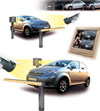

People that use ACSA facilities to fly somewhere and then fly back, want to find their car is safe and sound when they return and are happy to pay a secure parking fee for that peace of mind.
Vehicle security is increasingly becoming a priority consideration for office parks, residential complexes and large public facilities such as airports and rail terminals. The message that has begun to hit home is that if an organisation wants to continue doing good business it needs to assure its customers that their vehicles will be secure.
The Airports Company of South Africa (ACSA) is a prime example of a business that has fully realised the importance of providing secure parking for its customers. In embarking on a programme to extend parking facilities at Oliver Tambo International Airport, the ACSA IT Technology Department set out to achieve a number of objectives, namely:
* The best possible safety and security for vehicles and their owners using the facilities.
* Easy, quick vehicle access and egress to and from the complex.
* High reliability to minimise the delay effect of any system failure.
* The implementation of multiple lane systems, currently standing at 60.
* A system that will inform vehicle drivers where they will find unoccupied parking bays.
* Develop an infrastructure that will efficiently handle 30 000 vehicles a day.
* Allowing drivers to enter and exit the parking at the point most convenient to them.
* The ability to expand the system as needs arise.
While achieving a high degree of security, the system also had to keep entry and exit delay times to the minimum. Once a person has paid the parking fee at the pay-on-foot facilities the delay at the exit caused by ANPR is no more than half a second – the time taken for the software system to check the exit details against the entry details. Such a minimal delay time is critical when there are high volumes of vehicles exiting.
Therefore, a large centralised database back-up system with replicated servers is required if something goes wrong. However, with a distributed system, such as the Protoclea SINON solution applied at ACSA, the potential impact of any failure is much reduced. For example, if data is logged locally at each entrance, most of the functionality will be retained.
The image-based system designed to meet ACSA’s requirements had to have sufficient capacity to record and store images of vehicles entering and exiting. These images include the number plate, obtained through sophisticated ANPR (automatic number plate recognition) technology and the colour. In some systems an image of the driver, using facial recognition technology, is also taken and stored for comparison. Again database capacity is important to deal with the volume of images at the speed required.
Another important criteria for the ACSA IT Technical Department was that because the parking facilities at the airport are being extended with the construction of two new MSPs (multistorey parkades) that are part of the expansion of facilities for the 2010 FIFA Soccer World Cup, the parking security system had to be capable of expansion with planned architecture, modular growth and upgrade paths. The daily vehicle count at Oliver Tambo International is expected to climb to between 40 000 and 50 000 within the next five years.
Cameras and security design
A secure parking environment is one in which people may not leave the parking area with a vehicle that is not theirs. This involves a security structure that detects the vehicle licence plate and colour against the ticket issued to ensure that they match on exit. This, of course, is why it is so important that drivers take the parking ticket with them and do not leave it in the vehicle. Pay on foot systems ensure that this is generally the case.
While the level of security offered can be increased by using facial recognition and biometric technology to match the incoming driver image against that of the departing driver, this would not be necessary, and indeed not feasible, for this application. There will undoubtedly be instances where another person (wife, relative or friend) may accompany the driver to the airport, park, see the person off and then legitimately leave with the vehicle. If the ticket matches the incoming ticket there is no delay, but when a driver tries to exit with a ticket that does not match the entry ticket and the facial images do not match, then exit security has valid reasons for not allowing the vehicle to leave and for conducting further investigation.
The objective of the camera system is to detect the incoming and outgoing number plate of every vehicle as accurately as possible. It is not unreasonable to expect a character recognition level of 99%. Some number plates can be partially obscured by mud or add-on fittings such as bull-bars and fog or spot lights.
Automatic number plate recognition (ANPR) cameras must be powerful enough to accurately record number plate details at distances of more than 10 m. Controlled infra-red lighting is essential to brighten up the number plate and reflect an accurate image of the characters back to the camera both night and day and at sufficient resolution that the numbers and letters are easily read. As vehicles stop at the boom to collect their entry ticket, high shutter speeds are not required.
Cameras for facial recognition require careful selection and well-planned placement so that they may satisfactorily capture the facial image of the driver of a high SUV or 4x4 vehicle just as competently and easily as the drivers of conventional sedans and low-slung sports cars. Design, camera type and placement also have to take into account other complicating factors such as flash reflection from the windscreen or side window and if the angle is too wide, facial distortion can occur.
System operational experience
The operational experience at Oliver Tambo International Airport led the ACSA IT Technical Department to drive a number of design and practical application refinements. The initial facial cameras application demonstrated that it is better to use shorter focal lengths in order to obtain larger images and possibly to employ vertical video recording to overcome variances in vehicle heights.
The variances in the actual placement of number plates in different vehicles mean that it is not always possible to obtain an optimal recording of the number plate, depending on the vehicle type. Other ad hoc problems include people walking in front of the cameras at the crucial moment, which is difficult to prevent. However, the parking exit operator always has an alternative: making a physical check with the ticket held by the exiting driver.
The overall rate of detection achieved so far at ACSA parking is consistently well over 99%. The experience has shown that there are also more vehicles that do not have number plates than expected but the recorded images allow a match with vehicle driver and vehicle colour and, of course, the ticket issued.
The experience has also shown that a system of this size and capability simply cannot be obtained off the shelf. It needs to be structured, designed and built to meet specific end-use requirements and these requirements were clearly established by the ACSA IT Technical Department.
ACSA parking system successes
The vehicle security system at ACSA has consistently achieved:
* Very high detection accuracy.
* The ability to deal with multiple vehicles and exits.
* Quick, accurate responses to alarm triggers.
* Good relationships between supplier and client.
* Co-operation in the fine tuning of the system to meet all of the security objectives.
* Vehicle security has improved to the point where theft is almost non-existent.
* The system has proven to be expandable into an ever-growing solution.
Operator stations
One of the ACSA IT Technical Department’s major objectives in implementing the system was to ensure maximum vehicle security with minimal impact on people making use of the parking facilities. The system design therefore, limited operator interface to exceptions, which streamlines the overall process. This to some extent also dictated the design of the user interface, which provides operators with a list of events that constituted exceptions to the norm, rather than a list of events. The system also had to have the ability to support multiple operators who share the workload of dealing with the exceptions as efficiently and quickly as possible. Every event dealt with was therefore automatically locked, ensuring that other operators would deal with other exceptions. Through this the department ensured effective overall event management.
The system also provides event audit reports, forcing each operator to log in and acknowledge the action that was taken and the reasons for that action, which allows operator efficiency to be monitored and provides a tool by which staff performance can be continually improved through training based on actual occurrences.
Design specifications
With such large systems it is inevitable that some components will fail from time to time and therefore a comprehensive maintenance and monitoring programme was essential. This ensured that failures are red flagged immediately for the ACSA technical team and that Protoclea experts could deliver solutions for system reinstatement on demand.
System cost
Fair cost for a suitable solution depends upon two factors that have been determined by experience: the cheapest system simply will not cope with what is required and the most expensive system will invariably be overkill. To obtain the best value for money the ACSA IT Technical Department ensured the system to be implemented was expandable and upgradeable as this is less costly than disposing of a non-expandable system and buying a new one. The system costs were considered on a life-cycle basis to obtain the best 'bang for buck'.

For more information contact Dr Bennie Coetzer, Protoclea Advanced Image Engineering, +27 (0)11 465 4312, www.protoclea.com
© Technews Publishing (Pty) Ltd. | All Rights Reserved.